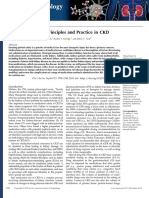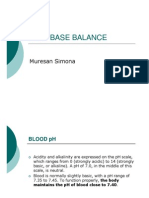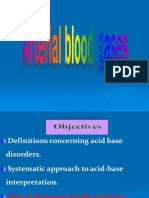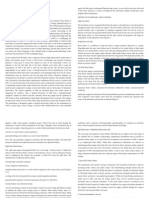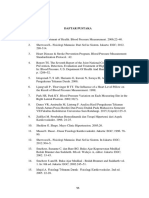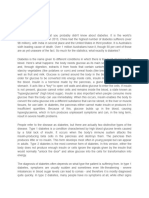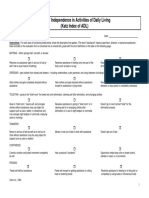Metabolic Acidosis
Metabolic Acidosis
Uploaded by
Desy Armalina AnwarCopyright:
Available Formats
Metabolic Acidosis
Metabolic Acidosis
Uploaded by
Desy Armalina AnwarCopyright
Available Formats
Share this document
Did you find this document useful?
Is this content inappropriate?
Copyright:
Available Formats
Metabolic Acidosis
Metabolic Acidosis
Uploaded by
Desy Armalina AnwarCopyright:
Available Formats
Metabolic Acidosis
By Candace McNaughton, ND
Bodycenter Studios, 126 NW Canal Drive, Suite #320, Seattle, Washington 98107 (206) 633-4800 ext.6 docmcnaughton@cs.com
August 2004
BACKGROUND: Metabolism is the process by which the body converts food into energy. Acidic and basic substances are created in this process. Acidic substances have a low pH, and basic substances have a high pH. The pH scale runs from 1 to 14, with 7 being neutral. A person's health depends in part on a proper ratio of acid and base in the body, known as "pH balance". The body typically keeps the blood in a pH range of 7.35-7.45 (See figure 1). If pH levels become imbalanced toward too acidic, "acidosis" results. If pH levels are too basic (also known as alkaline), "alkalosis" results. Metabolic acidosis, an imbalance associated with excess acidity in the blood, can occur as a result of numerous diseases and conditions. These include high protein diets, excess coffee and alcohol consumption, chronic disease, toxic exposure, vigorous exercise, dehydration, kidney disease, poisoning, shock, poor digestion, and the normal process of aging. Acidosis does not refer to "acid reflux" or heartburn, which has different causes. Figure 1: The pH of Blood
Metabolic Acidosis Metabolic Alkalosis
which is acidic. The lower intestines expel excess acid or base through the feces. The skin secretes acid through perspiration. Another mechanism the body uses to balance pH is the chemical buffers in the fluids and bone. Protein from muscle can be released to bind with acids in the blood. This can contribute to loss of lean muscle mass. Calcium and phosphorus in the bones can even become a buffer source because they can bind to acidic substances to neutralize them. This would exist in a more long term or serious condition, and can contribute to bone mineral loss. Other buffer systems include bicarbonate, hemoglobin, and the phosphate cycle. These are present in the blood and tissues and help to neutralize pH imbalance. When the capacity of these buffering systems is exceeded, it changes the pH balance and results in acidosis or alkalosis. Acidosis and alkalosis are disturbances indicating a pH imbalance in the blood. Although they are not diseases themselves, they can be signs of an underlying disease or condition. Even with our buffering systems working to maintain blood pH, we may have slightly more acidic blood than is healthy. This is because the buffering systems may not be working at their best. They can get overloaded and age just like we do. These buffering systems are critical to maintaining a healthy blood pH. They will maintain healthy blood pH at all costs. This means that measuring saliva or urine pH as normal or near normal will not tell you if the body is maintaining this pH by taking calcium from the bones or protein from the muscles. So, a slightly acidic blood can mean that the body is relying heavily upon buffering systems to maintain a near-normal pH at the expense of those organs and buffering systems. SO WHAT DOES pH IMBALANCE DO TO THE BODY? Imbalances in blood pH are classified in two main ways. These are metabolic and respiratory. Metabolic imbalances occur because of breakdowns in kidney function, ingestion or loss of imbalanced fluids, or other problems within the organs. Respiratory imbalances occur because of problems with oxygenation of blood: hyperventilation, stagnated blood flow, etc. So, the four main categories are Metabolic Acidosis, Metabolic Alkalosis, Respiratory Acidosis, and Respiratory Alkalosis. The dominant type of pH imbalance in western culture is metabolic acidosis. Metabolic acidosis is not a cause of heartburn, or acid reflux. Evidence indicates that metabolic acidosis is associated with kidney stones, gout, fibromyalgia,
continued on p. 2
6.8
Severe Disease 7 Neutral 7.35-7.45 Healthy Blood pH Severe Disease
7.8
HOW IS ACID-BASE BALANCE MAINTAINED IN THE BODY? The process of converting food to energy (metabolism) produces heat, carbon dioxide, water, and waste products. The waste products that result from the consumption of food are generally acidic, and they must be removed or neutralized to sustain a normal pH balance in the blood. In a healthy adult, blood pH levels range narrowly from 7.35 to 7.45, which is slightly alkaline (see figure 1). If blood pH falls below or rises above this range and remains at that level for more than a short time, serious health problems, and potentially death, can result. The body maintains a proper pH balance in various ways. Excess acid is bound to other molecules or expelled from the body. The organs responsible for maintaining proper body pH balance are predominantly the kidneys, lungs and, to a lesser degree, the skin and lower intestines. The kidneys filter the blood and remove excess acids and other substances. They excrete ammonia into the urine when the blood is acidic. They also return needed substances such as sugars, amino acids, and water to the blood. The lungs vent carbon dioxide, 2004 Candace McNaughton, ND
Page 2
Metabolic Acidosis by Candace McNaughton, ND
August 2004
interstitial cystitis, loss of muscle mass, osteoporosis, thyroid problems, cystic fibrosis, progression of HIV to AIDS, stunted growth of infants and children, irritable bowel syndrome, and even some forms of cancer, such as prostate cancer. Acidosis can also reduce enzyme activity, since enzymes function in narrow pH ranges in the body. Enzymes are very important proteins which are critical in almost all body processes, such as the breakdown of food. They are like tools. Running the body without enzymes is like trying to get a nail in a wall without a hammer. Metabolic acidosis is likely related to the excess amounts of protein, fat, refined flour, and sugar that are commonly consumed in the western world. These dietary patterns result in acidic metabolism. Other contributing factors are normal nutrient processing, toxic exposure, chronic disease, dehydration, severe diarrhea, and excess acid produced during exercise. Aging can contribute to metabolic acidosis as the function of the lungs and kidneys becomes less efficient. Other pH imbalances are less common. Respiratory acidosis and alkalosis are caused by lung malfunction (i.e., from smoking, altitude, or disease). Metabolic alkalosis is even less common because it is almost always caused by an abnormal condition such as bulimia or the consumption of an excessive amount of antacids. SUMMARY: Conditions such as high protein diets, chronic disease, toxic exposure, vigorous exercise, dehydration, and aging make the blood more acidic, which stresses the various buffer systems in the body. It is the overuse of the body's buffer systems, not the actual blood pH, which is the primary area of concern. The body works so hard to maintain a normal blood pH that it may result in damage to other areas of the body (such as the bone) in the process. So, a slightly acidic blood can mean that the body is relying heavily upon buffering systems to maintain a near-normal pH at the expense of those organs and buffering systems. Conditions associated with metabolic acidosis can result directly from acidic blood. They can also result from overuse of the body's buffer systems. With some correlated conditions, the connection is still being investigated. These conditions include kidney stones, fibromyalgia, interstitial cystitis, loss of muscle mass, osteoporosis, thyroid problems, cystic fibrosis, progression of HIV to AIDS, stunted growth of infants and children, irritable bowel syndrome, gout, the inactivation of body enzymes, and even some forms of cancer.
REFERENCES: 1. Abelow, Benjamin, Understanding Acid-Base, Williams and Wilkins, 1998 2. Aihara, Herman, Acid and Alkaline, George Ohsawa Macrobiotic Foundation, 1986 3. Arieff, Allen I., Hypoxia, Metabolic Acidosis, and the Circulation, Oxford University Press, 1992 4. Baroody, Theodore A., Alkalize or Die, Holographic Health Press, 1991 5. Brandis, Kerry, Acid-Base Physiology http://www.qldanaesthesia.com/AcidBaseBook, 2003 6. Klimet, Felicia Drury, The Acid Alkaline Balance Diet: an innovative program for ridding your body of acidic wastes, Contemporary Books, 2002 7. Merck, The Merck Manual of Medical Information, Merck Research Laboratories, 1997 8. Rhoades, R & Pflanzer, R., Human Physiology, Third Ed. San Diego: Saunders College Publishing, 1996 9. Vasey, Christopher, The Acid-Alkaline Diet for Optimum Health: restore your health by creating balance in your diet, Healing Arts Press, 1999 10. Whang, Sang, Reverse Aging, JSP Publishing, 1990 11. Wiley, Rudolf A., BioBalance - The Acid/Alkaline Solution to the Food-Mood-Health Puzzle, Essential Science Publishing, 1989 12. Young, Robert O. & Shelley R., The pH Miracle - Balance your diet, reclaim your health, Warner Books, 2002
You might also like
- Wgu Pathophysiology Study Guide d236 Pathophysiology Exam Questions Completed With Correct AnswersDocument12 pagesWgu Pathophysiology Study Guide d236 Pathophysiology Exam Questions Completed With Correct AnswersAllstudy100% (1)
- DOH Ambulatory Surgical Clinic LTO at 1262015rev1Document12 pagesDOH Ambulatory Surgical Clinic LTO at 1262015rev1al gul67% (3)
- DR Carl Reich MD FRCP - Calcium Vitamin D PaperDocument6 pagesDR Carl Reich MD FRCP - Calcium Vitamin D PaperAnonymous gwFqQcnaX100% (2)
- Cystic Fibrosis: Nature Reviews Disease Primers May 2015Document20 pagesCystic Fibrosis: Nature Reviews Disease Primers May 2015Tapan AnkleshwariaNo ratings yet
- Definingacutekidney Injury: Siddharth Verma,, John A. KellumDocument16 pagesDefiningacutekidney Injury: Siddharth Verma,, John A. KellumNicolas Peña RiveraNo ratings yet
- Caltech Coursera - Drugs&Brain - Report - Posting 8 Feb 2013Document12 pagesCaltech Coursera - Drugs&Brain - Report - Posting 8 Feb 2013Parker333No ratings yet
- Enzyme DeficienciesDocument5 pagesEnzyme DeficienciesMonty001No ratings yet
- BJA CEPD Reviews-2003-Schupp-69-74 PDFDocument6 pagesBJA CEPD Reviews-2003-Schupp-69-74 PDFRico Alfredo HutabaratNo ratings yet
- Acid Base HomeostasisDocument11 pagesAcid Base HomeostasisOrion JohnNo ratings yet
- Disorders of Water ImbalanceDocument22 pagesDisorders of Water ImbalanceRLauncherNo ratings yet
- Nephro Pharmacology For The Clinician.Document9 pagesNephro Pharmacology For The Clinician.Syed Yasir HusainNo ratings yet
- 2 Acid-Base ImbalanceDocument9 pages2 Acid-Base ImbalanceKhuzema SaeedNo ratings yet
- Xenobiotic MetabolismDocument64 pagesXenobiotic MetabolismBelajar dan berdoaNo ratings yet
- Renal Regulation of Acid-Base BalanceDocument10 pagesRenal Regulation of Acid-Base BalanceMarianela Vásquez ArayaNo ratings yet
- Answer Case Study 1 - Paracetamol Poisoning KLMPK 7Document6 pagesAnswer Case Study 1 - Paracetamol Poisoning KLMPK 7Jems OtnielNo ratings yet
- Potassium For Med StudentsDocument28 pagesPotassium For Med StudentsJoel Topf100% (11)
- Topical Corticosteroid AbuseDocument34 pagesTopical Corticosteroid AbuseDr Daulat Ram DhakedNo ratings yet
- Acid Base BalanceDocument11 pagesAcid Base BalanceAdriana Ardelean100% (1)
- Beta BlockersDocument70 pagesBeta BlockersIrina Cabac-PogoreviciNo ratings yet
- Drug Induced Liver Toxicity (DILD)Document39 pagesDrug Induced Liver Toxicity (DILD)Surya Pratama100% (1)
- Alawlaqi - Obesity FinalDocument26 pagesAlawlaqi - Obesity FinalMotea Alawlaqi100% (1)
- Clinical Alert A Quick Reference To Adverse Clinical EventsDocument272 pagesClinical Alert A Quick Reference To Adverse Clinical EventsOmasNers100% (1)
- Hypokalemia - Consequences, Causes, and CorrectionDocument10 pagesHypokalemia - Consequences, Causes, and CorrectionWawan BwNo ratings yet
- Exercise 9 - Renal System PhysiologyDocument18 pagesExercise 9 - Renal System Physiologynhungto740% (1)
- MDR PDFDocument16 pagesMDR PDFBandameedi RamuNo ratings yet
- Delayed Recovery After AnaesthesiaDocument5 pagesDelayed Recovery After Anaesthesiakoolstarone100% (1)
- Fluid, Electrolyte, and Acid-Base BalanceDocument61 pagesFluid, Electrolyte, and Acid-Base BalanceShanne PangpangdeoNo ratings yet
- Mcs Under SiegeDocument16 pagesMcs Under Siegeapi-269724919No ratings yet
- MNT For Sucrase Isomaltase DeficiencyDocument14 pagesMNT For Sucrase Isomaltase DeficiencySarah DresselNo ratings yet
- StrokeDocument102 pagesStrokea20-0353-958No ratings yet
- ICU - DR Abdullah AlRbiaanDocument224 pagesICU - DR Abdullah AlRbiaanAHMAD ALROWAILYNo ratings yet
- Fluid & Electrolyte TherapyDocument49 pagesFluid & Electrolyte TherapyrohitNo ratings yet
- Concentration of Urine: Maj DR Shavana R.L RanaDocument22 pagesConcentration of Urine: Maj DR Shavana R.L RanaChandan Sah100% (1)
- Approach To The Child With Metabolic Acidosis - UDocument3 pagesApproach To The Child With Metabolic Acidosis - URishi Shrestha100% (1)
- Daily Acid Load: Carbonic or Volatile Acid (H CO Carbonic AcidsDocument11 pagesDaily Acid Load: Carbonic or Volatile Acid (H CO Carbonic AcidsPrastia StratosNo ratings yet
- Full Download Guyton and Hall Textbook of Medical Physiology 14th Edition John E. Hall PDFDocument51 pagesFull Download Guyton and Hall Textbook of Medical Physiology 14th Edition John E. Hall PDFcrocekhabib80% (5)
- Shock and Circulatory FailureDocument8 pagesShock and Circulatory FailureOktaviana Sari DewiNo ratings yet
- Introduction To Acid Base Metabolic AcidosisDocument12 pagesIntroduction To Acid Base Metabolic AcidosisKris Sharine Batalla OderoNo ratings yet
- Heart Failure and Ejection FractionDocument1 pageHeart Failure and Ejection FractionCecil-An DalanonNo ratings yet
- t2dm Case StudyDocument17 pagest2dm Case Studyapi-300681452No ratings yet
- Microbial Activities and Intestinal Homeostasis A Delicate Balance Between Health and DiseaseDocument13 pagesMicrobial Activities and Intestinal Homeostasis A Delicate Balance Between Health and DiseaseitomoralesNo ratings yet
- Endocrine System Short Answer Questions - LA - AnswersDocument2 pagesEndocrine System Short Answer Questions - LA - AnswersVasantha SantaNo ratings yet
- Onconephrology Core Curriculum 2023Document19 pagesOnconephrology Core Curriculum 2023jogutiro01100% (1)
- Capnography Reference Handbook: Capnostat Loflo Flotrak Elite AccessoriesDocument40 pagesCapnography Reference Handbook: Capnostat Loflo Flotrak Elite AccessoriesLizzie RamosNo ratings yet
- Physiology Past SAQsDocument29 pagesPhysiology Past SAQsMatthew HoNo ratings yet
- Hypertention and HypotentionDocument46 pagesHypertention and HypotentionAmanuel MaruNo ratings yet
- ANZCA Training HandbookDocument114 pagesANZCA Training HandbookDavid WangNo ratings yet
- Antiseizure DrugsDocument55 pagesAntiseizure Drugsswapnali chougule100% (1)
- Envenomation and IntoxicationDocument37 pagesEnvenomation and IntoxicationYoelBagusGiartoNo ratings yet
- How To Read Arterial Blood Gas .PTDocument36 pagesHow To Read Arterial Blood Gas .PTMohd Erham bin JonohNo ratings yet
- Anesthetic Drugs PharmacologyDocument33 pagesAnesthetic Drugs PharmacologynasyariesNo ratings yet
- Topic Menopause and AdrenopauseDocument88 pagesTopic Menopause and AdrenopauseWikrom Keng WromKiNo ratings yet
- Amenorrhea WorkupDocument10 pagesAmenorrhea WorkupHaoKeat HoeNo ratings yet
- Renal SystemDocument85 pagesRenal SystemFerasKarajehNo ratings yet
- Anaesthetic Drug TablesDocument6 pagesAnaesthetic Drug TablesNanaNo ratings yet
- Chemical Pathology II HIV AIDSDocument33 pagesChemical Pathology II HIV AIDSSimeon AdebisiNo ratings yet
- How Does Obesity Cause DiabetesDocument3 pagesHow Does Obesity Cause DiabetesSafiya JamesNo ratings yet
- CHF PathophysiologyDocument4 pagesCHF PathophysiologyVirtudazo JessaNo ratings yet
- Disorders of Calcium and Phosphate MetabolismDocument20 pagesDisorders of Calcium and Phosphate MetabolismThirupathi Jakkani100% (1)
- Biotransformation SeminarDocument16 pagesBiotransformation SeminarShreyasNo ratings yet
- Oxygen: High Enzymatic Reactivity of Reactive Oxygen SpeciesFrom EverandOxygen: High Enzymatic Reactivity of Reactive Oxygen SpeciesNo ratings yet
- Physical Vascular Therapy - The Next Generation Of Medicine?: Microcirculation Of Blood - What Everyone Should Know AboutFrom EverandPhysical Vascular Therapy - The Next Generation Of Medicine?: Microcirculation Of Blood - What Everyone Should Know AboutNo ratings yet
- En PLC Lameness Final-2017Document4 pagesEn PLC Lameness Final-2017kasikayichipunzaNo ratings yet
- Chronic Kidney DiseaseDocument13 pagesChronic Kidney DiseaseJobelle AcenaNo ratings yet
- Final Essay MausDocument5 pagesFinal Essay Mausapi-242831588No ratings yet
- CookingDocument32 pagesCookingNightNo ratings yet
- Adoc - Pub - 32 Anderson P Anatomi Fisiologi Tubuh Manusia JakaDocument17 pagesAdoc - Pub - 32 Anderson P Anatomi Fisiologi Tubuh Manusia JakaIrdie Bhaktie BarmansyahNo ratings yet
- Primary Five - Set FiveDocument7 pagesPrimary Five - Set FivekemirembejoanitaNo ratings yet
- Pre-Dent Press 8.5Document8 pagesPre-Dent Press 8.5Corissa ChangNo ratings yet
- Neboshunit IbquestionsansmatrixDocument93 pagesNeboshunit IbquestionsansmatrixAli Usman100% (1)
- Reshmi ReportDocument2 pagesReshmi ReportSiddhesh Vishnu GaikwadNo ratings yet
- Semba TDocument3 pagesSemba Tsembakarani thevagumaranNo ratings yet
- Mood DisordersDocument16 pagesMood DisordersKathryn Alexis Mier IINo ratings yet
- Untitled DocumentDocument14 pagesUntitled Document1667 ShahriarNo ratings yet
- YogSandesh April Eng2012Document68 pagesYogSandesh April Eng2012Manmohan GuptaNo ratings yet
- AMALGAMDocument47 pagesAMALGAMSubhashini Rajshekar100% (3)
- Pelvic Organ Prolapse: Prof Hossam HusseinDocument71 pagesPelvic Organ Prolapse: Prof Hossam Husseinhossam626No ratings yet
- Genomics For The Child Neurologist Facilitator Guide Session Four Results Intepretation and ApplicationDocument7 pagesGenomics For The Child Neurologist Facilitator Guide Session Four Results Intepretation and ApplicationNational Coalition for Health Professional Education in GeneticsNo ratings yet
- Investigatory Biology Calss 12Document19 pagesInvestigatory Biology Calss 12DEEPAKNo ratings yet
- New Research Points To The People's Liberation Army Hospital in Wuhan, China As The Origin For The Worldwide Coronavirus PandemicDocument2 pagesNew Research Points To The People's Liberation Army Hospital in Wuhan, China As The Origin For The Worldwide Coronavirus PandemicDr QuayNo ratings yet
- WSDDocument13 pagesWSDhinatakunhinata75No ratings yet
- Paper PrefaceDocument3 pagesPaper PrefaceIntan SorayaNo ratings yet
- Ionized Water May Help These Common DiseasesDocument6 pagesIonized Water May Help These Common Diseasespawan kumarNo ratings yet
- Acupoint Stimulation For AcneDocument22 pagesAcupoint Stimulation For AcneCristian SauraNo ratings yet
- Prehospital Diabetic Emergencies BasicDocument13 pagesPrehospital Diabetic Emergencies BasicWenTzuNo ratings yet
- Priming and Regulation of Intravenous DeviceDocument35 pagesPriming and Regulation of Intravenous DeviceRaRe TV100% (1)
- Tomato-Fusarium Oxysporum Interactions - I - Chitosan and MSB Effectively Inhibits Fungal GrowthDocument5 pagesTomato-Fusarium Oxysporum Interactions - I - Chitosan and MSB Effectively Inhibits Fungal GrowthMaria de los Angeles Martinez PerezNo ratings yet
- Peperomia Pellucida in Diets Modulates Hyperglyceamia, Oxidative Stress and Dyslipidemia in Diabetic RatsDocument6 pagesPeperomia Pellucida in Diets Modulates Hyperglyceamia, Oxidative Stress and Dyslipidemia in Diabetic RatsMahati UlfahNo ratings yet
- Application of Microencapsulated Synbiotics in Fruit-Based BeveragesDocument10 pagesApplication of Microencapsulated Synbiotics in Fruit-Based BeveragesBruna ParenteNo ratings yet
- KAZT INDEX-ADLs PDFDocument2 pagesKAZT INDEX-ADLs PDFsintya dewi100% (1)










